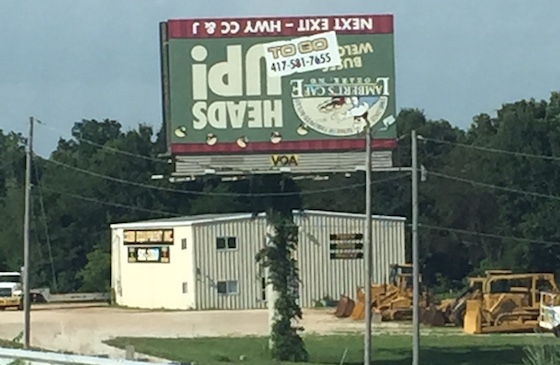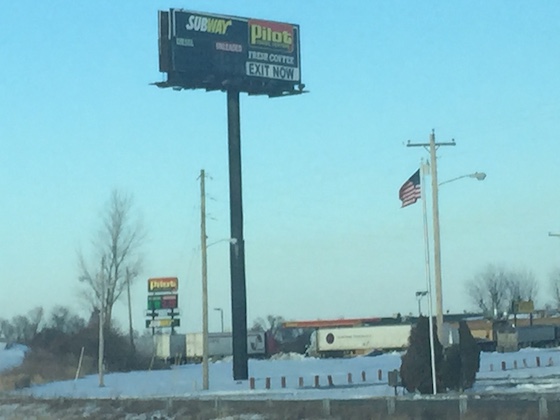Memo From Frank
April 15th was the IRS tax filing deadline. And every American takes a moment on that day to focus on their income for the past year. If you did not like what you saw – or wanted more – you should consider billboard investing. For as little as $1,000, you can increase your annual income by $3,000 per year or more, and with 10 of those under your built, you can have an additional income stream that is greater than the average earnings of a U.S. family of four. And that does not include extra effort to built that income stream into $100,000+ per year. If you have just finished your taxes and are thinking that you want more out of life, then you owe it to yourself to examine the options available in the billboard industry.
How The Highway Beautification Act Created The Modern Billboard Industry

This is a photo of the original artwork for the cover of The New Yorker magazine in 1947. It depicts what was a normal occurrence back then – billboards lining main roads at an incredible density. You still see that type of sign mania on old sections of Route 66. And if would be that way throughout America if it was not for the Highway Beautification Act of 1965. This simple gift from Congress forged the modern billboard industry as we know it (although nobody knew that would happen when they passed it).
Background
The story goes that Ladybird Johnson, wife of then President LBJ, was concerned about billboards being built near their family ranch in Austin, Texas. So she put together a coalition of Congressmen and cobbled together regulations that would stop those signs from going up. Titled the Highway Beautification Act, it became law in 1965. Prior to this act, there were no regulations regarding billboards in the U.S. You could put them anywhere, with no limitations. But after the Act was passed you could only install them in certain spacings and zonings.
Created scarcity
What the Act really did was create scarcity. Under the laws of supply and demand, the absence of supply creates higher pricing. But eliminating the ability to install signs anywhere you want, it made each existing sign more valuable, and the ad rents higher. Consider the fact that, prior to the Act, all signs were mostly built and owned by the advertisers themselves, since they needed no intermediary to get the permit and know the laws.
Provided Federal regulation and safety
The Act also legitimized the entire billboard industry, as the only other regulated U.S. industries at that time were the airline and trucking sectors. Prior to the Act, billboards were considered a fad and a nuisance and, afterward, a real business model. On top of that, the Act brought Federal protection for billboard owners against states mandating their removal.
The proof is in the numbers
Just look at what happened to billboard rents after the Act was established. Prior to the Act, they were about $100 per month or less. Following the Act they tripled, and have gone up about ten-fold since then. Without the Act, it’s possible that billboards would have mostly been abandoned, as competing media – such as TV – might have spelled their downfall. But the very Act that was designed to stop billboards actually is what created the modern industry.
And they can never deregulate
One interesting feature about billboards and Federal regulation is that it can never end. The U.S. later dropped both airlines and trucking from Federal oversight. But they can’t drop billboards. The reason is that environmental groups will not allow it to happen, as they like the restrictions. And that means the industry will always have the safety and security of the Act.
Conclusion
The Law of Unintended Consequences is very much in play with the Highway Beautification Act. This piece of legislation, that was designed to kill the billboard industry, actually created and strengthened it. And it can never be withdrawn, so it continues to provide higher pricing and legal protections for sign owners.
The Ultimate Billboard Boot Camp
![]() How to Find a Billboard Location
How to Find a Billboard Location
![]() How to Buy a Billboard
How to Buy a Billboard
![]() How to Build a Billboard
How to Build a Billboard
![]() How to Operate a Billboard
How to Operate a Billboard
![]() How to Rent Ad Space on a Billboard
How to Rent Ad Space on a Billboard
![]() How to Sell a Billboard
How to Sell a Billboard
Get Your Copy Now!
Should Your Billboard Be Upside Down?

Have you seen an upside down sign before? The answer is probably yes. So the question is: should you make one on your sign? There are some good and bad aspects to this concept.
Effective in getting attention
There’s no question that an upside down sign garners attention. Who doesn’t have curiosity in why it is upside down? If there are ten signs in a row on the highway, the one that is upside down will get the most viewers. It’s just human nature.
But hard to read the copy
That being said, it’s obviously very hard to read the actual copy on an upside-down sign. Just look at the above sample. And can you possibly read the copy on this ad and then think about the ad message while traveling at 70 mph? The answer is no. The ability to read and act on the advertisement is extremely limited.
Use only a few large words and a good graphic
If you have to experiment with this concept, the key is to use few words as they can’t easily be read. And use a good graphic as that can be interpreted upside down. Think about a billboard for a restaurant. You can mentally see bacon and eggs upside down, so at least the graphic is immediately understood.
The lesson of Kwik Wash
Kwik Wash built this business around being upside down. All their signs had the words upside down, and it kind of became their trademark. But that was just two words, and the colors gave away who it was after a while, I’m not sure, however, that there has ever been a successful upside down billboard campaign in American history.
Conclusion
Upside down signs are not a new invention. They are extremely odd and attention-getting. But their effectiveness may be imperiled due to the inability to grasp the message.
Can You Really Make A Fortune With The Billboard Industry?

Do you really think you can make big money in the billboard business? Well here are a few thoughts on this matter.
The power of scale
Billboards are extremely easy to manage. They have no moving parts and are built to withstand extreme temperatures and wind loads. You only rent the ads typically once per year. And you only have to drive out and check on them occasionally. This gives you the ability to own a huge number of them with limited time. If you have a wooden sign that makes $4,000 per year and you own 100 of them, that’s $400,000 per year. I personally managed 300 of them at the same time, so I can tell you that it’s possible to manage a lot of signs by yourself.
The existing track record
There are several billionaires who made their fortune in the billboard industry. They are Ted Turner, John Kluge and Arte Moreno. And then there are many, many multi-millionaires and millionaires who made their money with signs. If the industry did not offer strong rewards, then there could not be so many people who owe their financial independence to the billboard industry.
The opportunity is still there
There are still new fortunes being made in the industry every day. New signs are going up and old signs are being acquired. And there are still several public companies that buy billboards from other operators. It’s not too late to get involved.
Conclusion
The billboard industry is a great way to make money. It has been for decades. Don’t let any more time pass without exploring the possibilities.
Can A Billboard Be Too Tall?

My third billboard was 120’ tall. I was all excited about it. But then I realized that I overdid it. While a tall sign can be a good thing, an overly tall sign can be a hindrance. So what’s the truth about tall signs?
Tall signs get attention
There’s no question that tall signs are attention getting. You just naturally have to be curious about them. They tower over the other billboards, so the initial impression is that they must be superior. So most sign owners are prone to build their signs as high as they’re allowed by law.
They rise above the clutter
Another benefit to tall signs is that they rise about the clutter, such as trees and power line and other signs. This gives them uninterrupted visibility to virtually every car going down the highway. Since advertisers hate obstructions to their ads, this is a very admirable trait.
But they can also be hard to read
Here’s the tough part about tall signs. Although you can see them from far away, tall signs tend to go out of your windshield before they become fully legible. If you test this theory when you see the next really tall sign, you’ll find that they do not hit the industry standard 400’ of clear, legible read.
My experience
Here’s what I’ve learned from two decades of building tall signs. The key is this: MODERATION. Build signs that are above the clutter, but only barely. Make them taller than other signs, but not by much. Tall is great but too tall is terrible. Just don’t get carried away.
Conclusion
Make signs reasonably tall. Just don’t get carried away. At some point, the potential ad rents actually decline when you make signs too tall. Use moderation.
